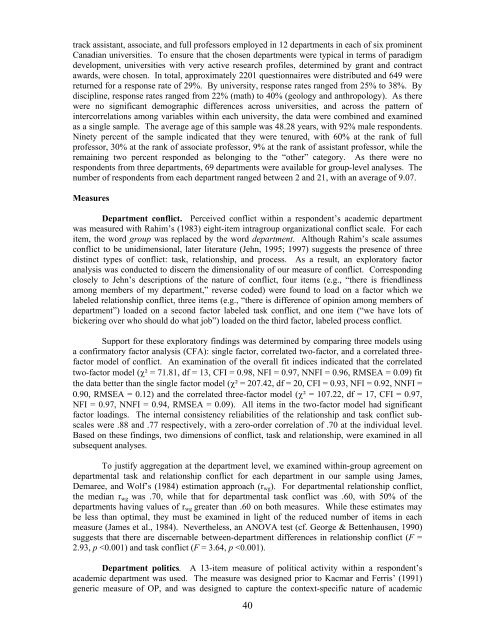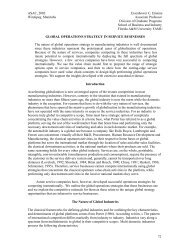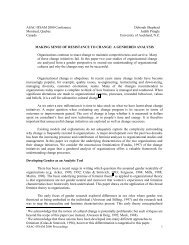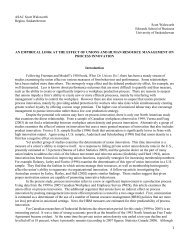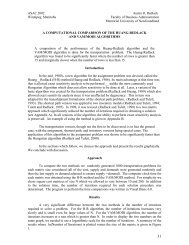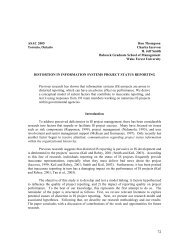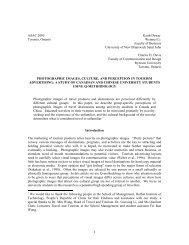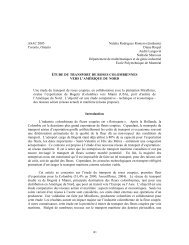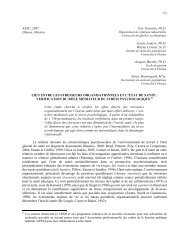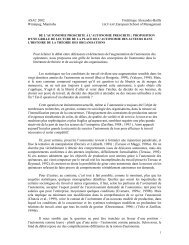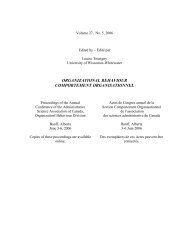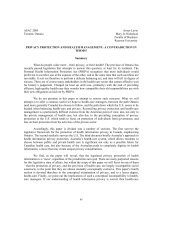track assistant, associate, and full professors employed in 12 departments in each of six prominentCanadian universities. To ensure that the chosen departments were typical in terms of paradigmdevelopment, universities with very active research profiles, determined by grant and contractawards, were chosen. In total, approximately 2201 questionnaires were distributed and 649 werereturned for a response rate of 29%. By university, response rates ranged from 25% to 38%. Bydiscipline, response rates ranged from 22% (math) to 40% (geology and anthropology). As therewere no significant demographic differences across universities, and across the pattern ofintercorrelations among variables within each university, the data were combined and examinedas a single sample. The average age of this sample was 48.28 years, with 92% male respondents.Ninety percent of the sample indicated that they were tenured, with 60% at the rank of fullprofessor, 30% at the rank of associate professor, 9% at the rank of assistant professor, while theremaining two percent responded as belonging to the “other” category. As there were norespondents from three departments, 69 departments were available for group-level analyses. Thenumber of respondents from each department ranged between 2 and 21, with an average of 9.07.MeasuresDepartment conflict. Perceived conflict within a respondent’s academic departmentwas measured with Rahim’s (1983) eight-item intragroup organizational conflict scale. For eachitem, the word group was replaced by the word department. Although Rahim’s scale assumesconflict to be unidimensional, later literature (Jehn, 1995; 1997) suggests the presence of threedistinct types of conflict: task, relationship, and process. As a result, an exploratory factoranalysis was conducted to discern the dimensionality of our measure of conflict. Correspondingclosely to Jehn’s descriptions of the nature of conflict, four items (e.g., “there is friendlinessamong members of my department,” reverse coded) were found to load on a factor which welabeled relationship conflict, three items (e.g., “there is difference of opinion among members ofdepartment”) loaded on a second factor labeled task conflict, and one item (“we have lots ofbickering over who should do what job”) loaded on the third factor, labeled process conflict.Support for these exploratory findings was determined by comparing three models usinga confirmatory factor analysis (CFA): single factor, correlated two-factor, and a correlated threefactormodel of conflict. An examination of the overall fit indices indicated that the correlatedtwo-factor model (χ² = 71.81, df = 13, CFI = 0.98, NFI = 0.97, NNFI = 0.96, RMSEA = 0.09) fitthe data better than the single factor model (χ² = 207.42, df = 20, CFI = 0.93, NFI = 0.92, NNFI =0.90, RMSEA = 0.12) and the correlated three-factor model (χ² = 107.22, df = 17, CFI = 0.97,NFI = 0.97, NNFI = 0.94, RMSEA = 0.09). All items in the two-factor model had significantfactor loadings. The internal consistency reliabilities of the relationship and task conflict subscaleswere .88 and .77 respectively, with a zero-order correlation of .70 at the individual level.Based on these findings, two dimensions of conflict, task and relationship, were examined in allsubsequent analyses.To justify aggregation at the department level, we examined within-group agreement ondepartmental task and relationship conflict for each department in our sample using James,Demaree, and Wolf’s (1984) estimation approach (r wg ). For departmental relationship conflict,the median r wg was .70, while that for departmental task conflict was .60, with 50% of thedepartments having values of r wg greater than .60 on both measures. While these estimates maybe less than optimal, they must be examined in light of the reduced number of items in eachmeasure (James et al., 1984). Nevertheless, an ANOVA test (cf. George & Bettenhausen, 1990)suggests that there are discernable between-department differences in relationship conflict (F =2.93, p
politics (cf. Johns 2001; Rousseau & Fried, 2001). Respondents described their department’spractices regarding each activity (e.g., promotion decisions, curriculum design) on a five-pointscale ranging from not at all political to extremely political. A factor analysis confirmed aunidimensional structure, with item loadings ranging between .57 and .80, and an internalconsistency reliability of .92. As this measure was to be used at the group level, we employedJames et al.’s (1984) estimate of within-group agreement. The median r wg was .93, withapproximately 95% of departments having values greater than .60.Paradigm Development. Paradigm development ranks were assigned to academicdepartments and their corresponding members based on rankings obtained from previous primaryresearch (see Lodahl & Gordon, 1972; Salancik, Staw, & Pondy, 1980; Pfeffer & Moore, 1980).Paradigm development was indexed as the average rank of the twelve academic departmentscommon to Pfeffer and Moore (1980) and Salancik et al. (1980), excluding biology, whichexhibits an unstable ranking. The rank order assigned to the twelve departments studied here(from lowest to highest paradigm development) is: sociology (ranked 1); political science;history; anthropology; geology; economics; psychology; chemistry; mechanical engineering;physics; electrical engineering; mathematics (ranked 12).Role ambiguity and role conflict. Six items, adapted from Rizzo, House, and Lirtzman(1970), were used to measure role ambiguity. Respondents were required to indicate the extent towhich they agreed with each statement, using a 7-point Likert-type scale ranging from 1 =disagree strongly to 7 = agree strongly. The internal consistency reliability estimate for thismeasure was .78. Role conflict was also measured using eight items from Rizzo et al. (1970),which had an internal consistency reliability of .84.Rank heterogeneity. We used Blau’s (1977) heterogeneity index to measure rankdiversity for each department. Information on rank composition was obtained by consulting eachuniversity’s annual calendar. As our sample comprised individuals at the assistant, associate, orfull professor rank, we counted the number of faculty in each of these three rank categories only.As two departments within a single university did not organize their faculty list by rank, we couldnot compute measures of heterogeneity for these departments.Control variables. Department size and demographic variables such as age, gender, andyears in department were controlled because these variables have been found to be associatedwith perceptions of politics (e.g., Madison, Allen, Porter, Renwick, & Mayes, 1980; Anderson,1994; Ferris, Frink, Bhawuk et al., 1996; Ferris & Kacmar, 1992). A measure of department sizewas created by obtaining information from annual university calendars. The measure reflectedthe number of faculty from the three ranks listed previously. As departmental task andrelationship conflict measures varied across universities, it was necessary to control for universitywhen examining associations involving either of these variables. Five dummy coded vectorswere formed to signify membership in a university, and individuals and departments were bothassigned a value of 1 or 0 because many hypotheses involved cross-level associations.Discriminant validity. To ensure that our self-report measures of role ambiguity, roleconflict, department conflict, and politics assess different constructs, we conducted a principalcomponents factor analysis . Results of a four-factor, rotated solution confirmed the distinctnessof these measures, with items loading on their respective factors (see Appendix A).ResultsTables 1 and 2 present descriptive statistics and correlations for variables at theindividual and department levels. At the individual level (Table 1), age, rank and years indepartment are highly and positively associated with each other. As expected, role ambiguity and41
- Page 1 and 2: Volume 24, No. 5, 2003Edited by/Éd
- Page 4 and 5: Pursey HeugensGreg IrvingRoderick I
- Page 6 and 7: TABLE OF CONTENTS - TABLE DES MATI
- Page 8 and 9: study of power displays in mixed-ge
- Page 10 and 11: on expectations and behaviour (Berg
- Page 12 and 13: TaskThis study required the use of
- Page 14 and 15: Task-Gender (male-stereotyped or fe
- Page 16 and 17: It is important to understand the s
- Page 18 and 19: Crown, C.L. & Cummins, D.A. (1998).
- Page 20 and 21: Smith-Lovin, L., & Brody, C. (1989)
- Page 22 and 23: Table 2Summary of Descriptive Stati
- Page 24 and 25: Table 4Summary of Interaction of Ge
- Page 26 and 27: ASAC 2003Halifax, Nova ScotiaIain L
- Page 28 and 29: the interrelationships among the MB
- Page 30 and 31: studies (Friedman and Sarros, 1989;
- Page 32 and 33: This study demonstrated that emotio
- Page 34 and 35: Anxiety, Stress and Coping, in pres
- Page 36 and 37: Washington, DC: Taylor and Francis,
- Page 38 and 39: Table 2Overall Goodness-of-Fit Indi
- Page 40 and 41: ζ 3Depersonalizationη 3β 3,1 (+)
- Page 42 and 43: ASAC 2003Halifax, Nova ScotiaWendy
- Page 44 and 45: views independently, gave rise to S
- Page 48 and 49: ole conflict are positively related
- Page 50 and 51: Table 3. Regression of climate and
- Page 52 and 53: interests.We speculate the null eff
- Page 54 and 55: DOOP and short for DOOP scales,”
- Page 56 and 57: Pelled, L. H., “Demographic diver
- Page 58 and 59: esulting increase in discretion ove
- Page 60 and 61: al., 1995). However, the distinctio
- Page 62 and 63: ise to strong pressures for conform
- Page 64 and 65: presented with a complete list of a
- Page 66 and 67: Table 3QAP Regression Coefficients
- Page 68 and 69: ConclusionResearchers of social inf
- Page 70 and 71: suggestions for further research.
- Page 72 and 73: performing on the job.” Presumabl
- Page 74 and 75: positively related to performance i
- Page 76 and 77: proposed hypotheses were supported.
- Page 78 and 79: ConclusionThis research has made se
- Page 80 and 81: Be more enthusiastic and exert extr
- Page 82 and 83: Table 2Correlations Among the Laten
- Page 84 and 85: performance expectations on feedbac
- Page 86 and 87: changements qui s’opèrent dans l
- Page 88 and 89: structures, politiques, systèmes,
- Page 90 and 91: comportements liés à la communica
- Page 92 and 93: Tableau 2Échelles de mesure de la
- Page 94 and 95: prédiction des compétences clés
- Page 96 and 97:
organisation n’est pas uniforme e
- Page 98 and 99:
complètement ce construit. Ces cha
- Page 100 and 101:
Wagner, R.K. and Sternberg, R.J. (1
- Page 102 and 103:
What is a toxin handler?In two arti
- Page 104 and 105:
potentially limited scope and conte
- Page 106 and 107:
work role demands. In this survey,
- Page 108 and 109:
The three factors in this rotated f
- Page 110 and 111:
and service orientation, the abilit
- Page 112 and 113:
ASAC 2003Halifax, Nova ScotiaLisa M
- Page 114 and 115:
self-appraisal group reacted more n
- Page 116 and 117:
effect of voice are the value-expre
- Page 118 and 119:
“Strongly Disagree” to “Stron
- Page 120 and 121:
esults suggest that incorporating s
- Page 122 and 123:
Personality and Social Psychology,
- Page 124 and 125:
Table 1Means, Standard Deviations,
- Page 126 and 127:
Table 3Test of the Mediating Role o
- Page 128 and 129:
ASAC 2003Halifax, Nova ScotiaAnn Fr
- Page 130 and 131:
individual level, polychronicity is
- Page 132 and 133:
construct.Drawing on computer-media
- Page 134 and 135:
Consequence: Impact on Work Overloa
- Page 136 and 137:
Conversation complexity may also mo
- Page 138:
Implications for practiceFuture res
- Page 141 and 142:
ReferencesAncona, D.G., Goodman, P.
- Page 143 and 144:
no. 3 (1994): 381-391.Macan, T.H.,
- Page 145 and 146:
ASAC 2003Halifax, Nova ScotiaIan R.
- Page 147 and 148:
Assessing Measures: Affective Commi
- Page 149 and 150:
implications of psychological contr
- Page 151 and 152:
commitment, affective commitment, c
- Page 153 and 154:
Motivational Process Variables. Amo
- Page 155 and 156:
DiscussionThe main purpose of this
- Page 157 and 158:
approaches zero. In the present stu
- Page 159 and 160:
Extension and test of a three-compo
- Page 162 and 163:
Table 1Descriptive Statistics and Z
- Page 164 and 165:
Table 3Standardized Factor Loadings
- Page 166 and 167:
Table 5Hierarchical Regression Anal
- Page 168 and 169:
ASAC 2003Halifax, Nova ScotiaJoan F
- Page 170 and 171:
ASAC 2003Halifax, Nova ScotiaArla D
- Page 172 and 173:
ASAC 2003Halifax, Nova ScotiaIvy Ky
- Page 174:
ASAC 2003Halifax, Nova ScotiaNina D


